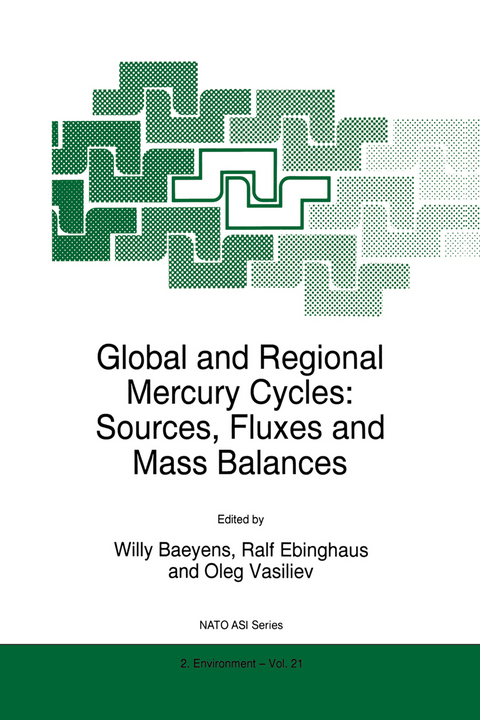
Global and Regional Mercury Cycles: Sources, Fluxes and Mass Balances
Springer (Verlag)
978-94-010-7295-3 (ISBN)
Audience: Environmental scientists, legislators, politicians and the interested citizen wishing to gain a clear picture of the biogeochemical cycling of mercury.
1. Analytical Aspects on the Determination of Mercury.- 1.1. Mercury Analysis and Speciation in Environmental Samples.- 2. Mercury Fluxes and Budgets.- 2.1. Global Regional and Local Mercury Budgets.- 2.1.1. Trends in Atmospheric Mercury Concentrations over the Atlantic Ocean and at the Wank Summit, and the Resulting Constraints on the Budget of Atmospheric Mercury.- 2.1.2. The Global Mercury Cycle: Oceanic and Anthropogenic Aspects.- 2.1.3. Estimation of Atmospheric Input and Evasion Fluxes of Mercury to and from the Great Lakes.- 2.1.4. A Regional Mercury Budget for Siberia and the Role of the Region in Global Cycling of the Metal.- 2.1.5. Emission and Local Deposition Estimates of Atmospheric Mercury in North-Western and Central Europe.- 2.2. Emission Inventories and Regional Transport Models for Mercury.- 2.2.1. Emission Inventories of Atmospheric Mercury from Anthropogenic Sources.- 2.2.2. Inventory of North American Hg Emissions to the Atmosphere.- 2.2.3. Numerical Modeling of Regional Transport, Chemical Transformations and Deposition Fluxes of Airborne Mercury Species.- 2.2.4. A Model of the Chemical Transformation of Mercury and its Long-Range Atmospheric Transport.- 2.3. Mercury Cycling in the Oceans.- 2.3.1. Mercury Fluxes at the Ocean Margins.- 2.3.2. Sources, Sinks and Biogeochemical Cycling of Mercury in the Ocean.- 2.4. Mercury in Lakes, Rivers and Estuaries.- 2.4.1. Mercury in the Katun River Basin: A Case Study of a Naturally Polluted System.- 2.4.2. Particulate, Dissolved and Methylmercury Budgets for the Scheldt Estuary (Belgium and the Netherlands).- 2.4.3. Mercury Distribution and Fluxes in Lake Baikal.- 2.4.4. The Elbe River: A Special Example for a European River Contaminated Heavily with Mercury.- 2.4.5. Mass Balance Studies of Mercury and MethylMercury in Small Temperate/Boreal Lakes of the Northern Hemisphere.- 2.5. Hg in Terrestrial Systems.- 2.5.1. Forests and the Global Biogeochemical Cycle of Mercury.- 2.5.2. Terrestrial Mercury and Methylmercury Budgets for Scandinavia.- 2.5.3. The Role of Organic Matter in Mercury Cycle.- 3. Natural and Industrial Sources of Mercury.- 3.1. Eastern Europe and Siberia.- 3.1.1. Mercury Contamination of the Environment due to Gold Mining in Zabaikalye.- 3.1.2. Industrial Mercury Sources in Siberia.- 3.1.3. Mercury Speciation in Mineral Matter as an Indicator of Sources of Contamination.- 3.1.4. Natural Mercury Sources in the Environment: Contribution of Siberia.- 3.1.5. Mercury in Geological Systems.- 3.1.6. Mercury in Soils of the Southern West Siberia.- 3.1.7. Case Studies on Mercury Related Environmental Problems in Hungary.- 3.1.8. Mercury in the Environment of the Central Part of the Balkan Peninsula.- 3.2. Tropical Regions.- 3.2.1. Scope Project: Evaluation of the Role and Distribution of Mercury on Ecosystems with Special Emphasis on Tropical Regions.- 3.2.2. Lessons and Questions from Studies on Mercury in the Amazon Region.- 4. Conclusions of the Working Group Discussions.- 4.1. Working Group Report on Atmospheric Mercury.- 4.2. Working Group Report on Oceanic Mercury Cycling.- 4.3. Working Group Report on Terrestrial Mercury Cycling.- 4.4. Working Group Report on Inland Waters.
| Reihe/Serie | NATO Science Partnership Sub-Series: 2 ; 21 |
|---|---|
| Zusatzinfo | XXVIII, 563 p. |
| Verlagsort | Dordrecht |
| Sprache | englisch |
| Maße | 155 x 235 mm |
| Themenwelt | Naturwissenschaften ► Biologie ► Ökologie / Naturschutz |
| Naturwissenschaften ► Chemie ► Anorganische Chemie | |
| ISBN-10 | 94-010-7295-7 / 9401072957 |
| ISBN-13 | 978-94-010-7295-3 / 9789401072953 |
| Zustand | Neuware |
| Haben Sie eine Frage zum Produkt? |
aus dem Bereich


